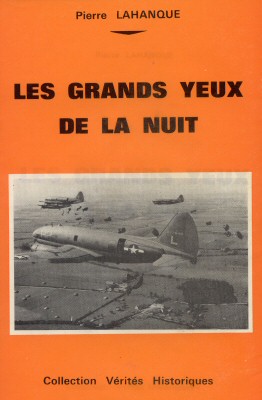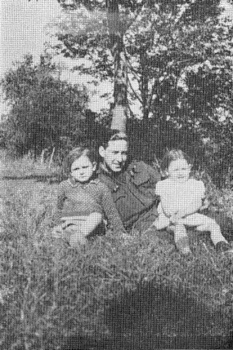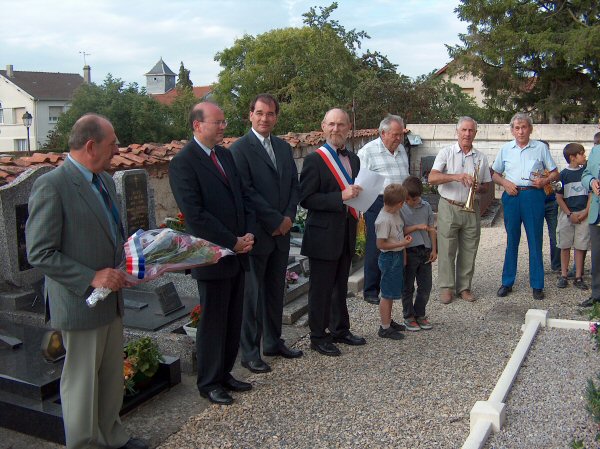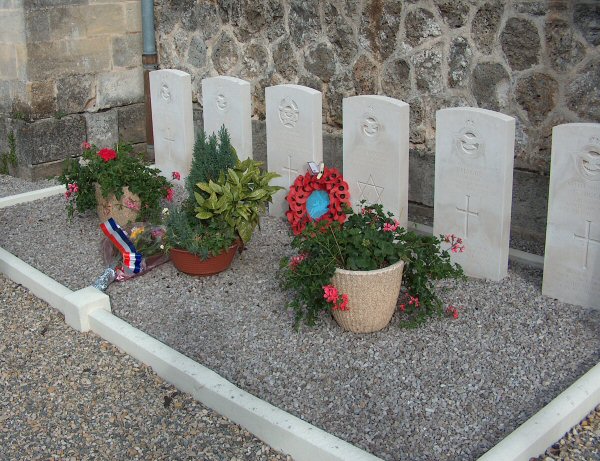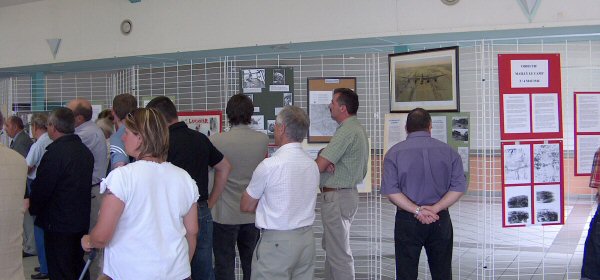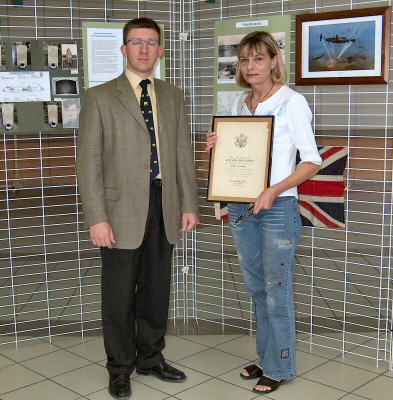207 SQUADRON ROYAL AIR FORCE HISTORY
The McNaughton Crew - Lancaster PD210 EM-C
Revigny Raid 18/19 July 1944 - crashed St Germain la Ville,
Marne
Pilot: McNAUGHTON, F/O William Ross RAFVR age 20
Flight Engineer: SUPKOVITCH, Sgt Alfred RAFVR age 19
Navigator: HAGUE, F/Sgt John RAFVR age 22
Air Bomber: TIBBS, F/O Rowland RAFVR age 22
Wireless Operator: CHAPPLE, Sgt John Kenneth RAFVR evaded
capture
Mid Upper Gunner: HIGGINS, Sgt Charles RAFVR age 24
Rear Gunner: EDMUNDS, P/O Howard Frederick RCAF age 21
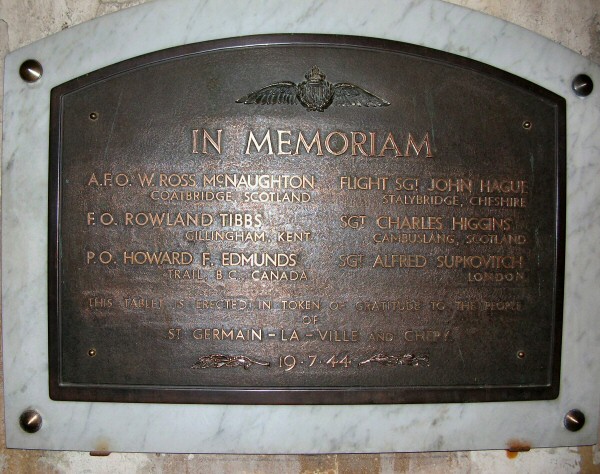
The plaque in the church, after cleaning in 2007: Deludet
This Tablet is erected in token of gratitude to the people of
St Germain-La-Ville and Chepy
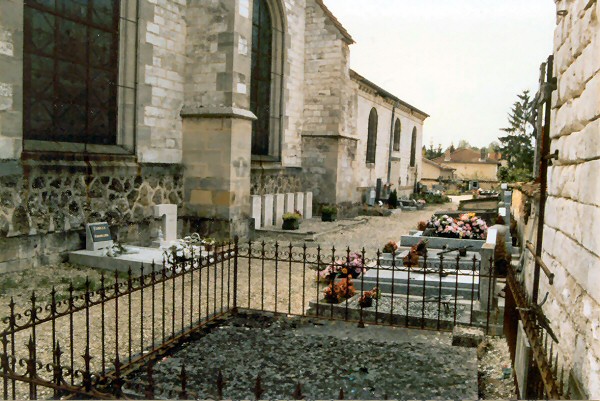
The crew graves (centre) in the churchyard, 1990: Clutton-Brock
from the 207 Squadron RAF Association Newsletter, Summer 2001
In February the Association was contacted by Trevor Deeley, the Secretary of the Redditch Branch of the Parachute Regiment Association, to let us know that on 20th April a party from his Branch would be visiting the town of Vitry-le-Francois at the invitation of their French counterparts, L'Amicale Parachutistes.
On Saturday 21st April the first event of their day was to be a visit to the churchyard cemetery of St Germain-La-Ville to pay homage at the graves of '6 RAF flyers'. Trevor set about finding out who these were. He contacted the Commonwealth War Graves Commission who told him they were on 207 Squadron. A search of the Internet found 207's website. These 'RAF flyers' were F/O William McNaughton and five members of his crew, one of three crews 207 lost on Revigny. The seventh crew member, Sgt John K Chapple the Wireless Operator, survived by being thrown clear when his Lancaster exploded.
One of those killed was F/S John Hague, who has been the subject of study by his great nephew, Matthew Knott, as described in an earlier newsletter.
A further amazing coincidence was that at the end of last year we enrolled a Friend member, Mrs Stella Caldwell who was the widow of F/O R Tibbs, the Bomb Aimer of F/O McNaughton's crew. She had been researching her husband's death. When informed of the proposed visit to the graves of F/O McNaughton's crew by Trevor Deeley's group she promptly contacted Trevor, resulting in her and her son accompanying the party to France.
The Service at the graveside took place as arranged on Saturday 21st April and was conducted by the Parachute Regiment Padre accompanying the party. Our Association provided six rosettes, one placed on each grave on behalf of our members. The French hospitality bestowed upon the party was apparently as tremendous as any we, on our many visits [to Europe], have experienced.
One final touch of sheer humanity was displayed by a French lady who, when Trevor remarked on the siting of the graves, said "We buried the boys there on purpose so that they would be facing home".
We are very grateful to Trevor Deeley for his interest and for honouring this 207 crew.
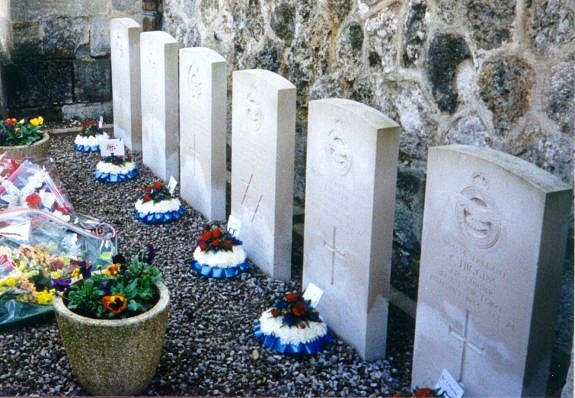
St Germain-La-Ville: six of the McNaughton crew, our
rosettes laid at each headstone:
(L-R) McNaughton, Tibbs, Edmunds, Supkovitch, Hague, Higgins,
2001: Deeley
Failed to Return
18-19 July 1044 207 Sqn Lancaster I PD210 EM-C Op:
Revigny
t/o 2253 Spilsby to destroy a railway junction.
Homebound, believed to have fallen victim to a FW190 whose
cannon fire caused the Lancaster to explode, ejecting Sgt
Chapple. The bulk of the wreckage fell at St Germain-la-Ville
in the Marne, a village W of the road twixt
Châlons-sur-Marne and Vitry-le-Francois. Those who died lie
in St Germain-la-Ville Churchyard.
(from WR Chorley's 1944 volume in the series RAF Bomber Command Losses of the Second World War)
207 Squadron lost three Lancasters of the ten sent from RAF Spilsby on the night of 18/19 July 1944 on the operation to Revigny. The other two aircraft were:
F/O Weekes' crew ME681 EM-T
memorial dedication visit 21 July 2001
F/O Jesse G Dallen's crew ME814 EM-E
The background to the Revigny raids is explained (in French and English) by the former Secretary of the Association, Ron Winton ISM, at The Revigny Raids, 207 Squadron RAF History
The evasion debriefing report for Sgt JK Chapple (ref IS9/WEA/MB/1333, dated 11 Sep 44) is brief:
"I was Wireless Operator in a Lancaster which left Spilsby at [unreadable] hours on 18 July 1944. I baled out at 0200 hours on 19 July 1944 and landed in cornfields approximately 1 mile from St Germain la Ville. I buried my parachute and mae west in a ditch and walked ?wards until dawn. I hid in woods watching the nearby road until 1530 hours. I saw two French peasants and asked them for [help]. They said they could not help but they returned with another Frenchman who hid and kept me at his house until I was liberated."
John Chapple's story is related in Oliver Clutton-Brock's book Massacre over the Marne - The RAF Bombing Raids on Revigny, July 1994 (Patrick Stephens, 1994), reproduced here by kind permission of Oliver, who is a Friend Member of the Association:
"It was mid-day on a hot summer's day and Pierre Lahanque, the village baker at Marson, a small village some six miles south-east of Châlons-sur-Marne, was about to sit down to a well-earned meal when the bell rang. He found a woman in a state of considerable agitation. She explained that she had found a wounded man near a calvary on a ridge off the road from Chalons. Could he help?
Indeed he could, despite serious doubts that it was a Gestapo trick. Nevertheless, he arranged to meet the woman near the calvary. They would go independently. Filling his pockets with water, sugar and a first aid kit, he grabbed his bicycle (stolen from the SS!) and set off. When the woman arrived, she pointed into the trees. A wounded man who had been leaning against the trunk of a fir tree was trying to get up. Pierre motioned him to stay where he was. There was no mistaking the uniform of an Allied airman, nor that he was wounded. Pierre indicated to the woman that it was best for her to leave and, turning to the airman, told him that he would take him back to his house, but not in broad daylight and in uniform.
Pierre asked what had happened and the airman explained that they had been attacked by a night-fighter, possibly an FW190, that had taken them by surprise. It was all over in a few seconds. The fuel tanks exploded and that was the end of Lancaster PD210. Only he, the wireless operator, was blown clear. He added that the rest of the crew were dead. Pierre asked him how he could be sure of this, and the man replied that as he floated down, the sky lit up by the blazing Lancaster, he could see no other parachute. He was alone.
His name was John Chapple, and he came from London.
Pierre told John that he would return after dark to collect him. He went home and told his wife what had happened, then set off to look for the remains of the Lancaster and its crew, just in case. Searching high and low he came upon the tail section sitting there `like an enormous toy', riddled with cannon holes. Then he found the first body. It was lying in a pool of blood, the blue-grey uniform now predominantly red. The dead man's partially deployed parachute was beside him. As Pierre spread it out, he could see that it had been so badly burned that it could have been of no use.
He continued looking for the rest of the aircraft and then saw it, close to an elm tree, broken and burnt like a half-smoked cigar. An engine had scythed a path through the long grass, its propellers sticking into the earth. The huge wheels were some way away. There was no sign of anyone in the fuselage.
Widening his search with each circuit of the wreck, he found a second body. The dead man was lying on his back, his eyes staring unseeing at the sky. Then a third corpse, horribly broken, a light breeze ruffling red hair. Pierre read the word Canada on the upper arm. The fourth and fifth men were soon located, close together. But of the sixth body there was no sign. Pierre determined to find the man who might, perhaps, be wounded and hiding in the woods. The light was fading fast. First he had to find John Chapple again.
John was unconscious, and with difficulty Pierre got him to his feet and helped him back to his house in Marson. His uniform was removed and his wounds dressed as well as possible; John had a graze across his forehead and a dislocated right leg. He was also grief stricken at the loss of his comrades, and was in a state of shock and refused to speak. He spurned, too, the offer of food and drink. Pierre understood, and let him be.
Six days later they went to the site of the crash, and searched desperately for the missing man. The other bodies had long since been removed and buried. It was a blazing hot day and they stopped for a rest. A shout echoed across the fields. Germans! Pierre told John to act deaf and dumb. Two men in uniform were coming towards them. There was no escape. The men got closer. Thank God! The 'Germans' were French workmen in their blue overalls!
The men had discovered a body in an oat field. The four of them walked back to the body which, sure enough, was that of the missing airman. He had fallen like a stone, without his parachute, his oxygen mask still across his mouth. Pierre told the two workmen to contact the mayor of St Germain to arrange for the burial. As they went their separate ways, John told Pierre that they had just found his pilot, Ross McNaughton.
Life went on. John remained at the bakery at Marson, where there were occasional moments of high tension, the Germans being wont to call at any time demanding food and drink. Once two soldiers entered the bakery without knocking. They were looking for lodgings but, despite Pierre's assurance that there were but two rooms one for him and his wife and the other for their two young children, they insisted on searching the premises. Outside they saw a ladder leading to a loft and demanded to know what was up there. Pierre's heart began to pound, but he blurted out that it was only the store for the grain. The Germans wanted to have a look anyway. Now Pierre was in trouble, for in the store was John's bed, and John was in it. Pierre thought about grabbing the feldwebel's pistol and shooting them, but decided that it was too risky. They burst into the room, and there in the far corner was the bed. Beside it was a French-English dictionary, with brightly embossed gold letters on the cover. One of the men pulled the blanket off the bed and stepped back, pointing. Pierre had to think fast:
"He's my worker, do you understand? He's very tired. Makes the bread at night, then sleeps a little, like that."
"Yes, yes", replied the soldier. "Understood."Pierre's heart returned to its natural position and they, filed out, the dictionary unnoticed. Back in the house, the soldiers demanded champagne and Pierre decided that this was the right moment to produce a bottle. The soldiers consumed the contents and left.
Pierre tried to get John sent home, but an influential member of the Resistance told him that it was too risky. Days passed. American bombers often flew overhead, to remind them that there was a war on.
believed to have been published after May 1974
John Chapple with the Lahanque children: via Oliver Clutton-Brock, from Pierre Lahanque's book (left) from which much of John Chapple's story is sourcedThen, on 27 August, the sound for which they had been waiting so long - the distant rumble and thunder of American armour. Free at last, but before he could go home John was asked to attend mass at the church at St Germain-la-Ville, where his six comrades were buried. The curate, Monsieur Vinot, summoned everyone from the area to be present to honour the young men who had given their lives for Liberty. The church was packed to overflowing when the curate suddenly announced John's presence amongst them.
It was a highly emotional moment. Everyone, tried to shake John's hand, to give thanks for the supreme sacrifice made on their behalf. Speeches were made and, when it was all over, the people filed past the six graves barely visible beneath a mass of flowers. There was many a tear-stained cheek that day. Goodbyes were said and John went home."
John Chapple died in London in April 1984.
In 2004 the Association sent this message to the Mayor of St Germain la Ville:
M le Maire, honoured guests, the people of St Germain la Ville, and visitors. No.207 Squadron RAF Association is honoured that the people of St Germain la Ville continue their appreciation and respect for the crew of Lancaster EM-C PD210 which fell on 19th July 1944, resulting in the death of six of them, the seventh managed to evade capture.
Thanks to M Florent Deludet, a Friend member of our Association, we are kept in touch with his research. We commend the event which he has helped to create and which we intend will soon be available for the world to see on our Association's website.
We are sorry we could not be present. We have just returned from ceremonies at Neaufles Saint Martin and Sérifontaine to commemorate crews from 207 Squadron lost in the attacks on V1 weapon stores earlier in July 1944.
We not only remember our fallen with sorrow and pride but the gallantry and sacrifice of the many French people who at great risk assisted those who evaded capture and who, despite the occupiers, honoured our dead.
These events remind us that our present freedom was bought with the sacrifice of so many young men and their hopes and dreams, and the sorrow of those who loved them:
When you return home, tell them of us, and say
For your tomorrow, we gave our today.« Quand tu reviendras à la maison, parle-leur de nous, et dis-leur,
Pour votre demain, nous avons donné notre aujourd'hui »
Inscription dans un cimitière britannique de la guerre 39-45
July 2004: The Mayor and officials, wreath laying at the graves: Deludet
July 2004: The graves after the wreath laying: Deludet
July 2004: part of the exhibition: Deludet
July 2004: Florent Deludet (wearing a 207 Association tie)
with a daughter of Pierre Lahanque: Deludet
Florent Deludet wrote in 2002:
I began to be interested in this crew when I met my wife 10 years ago. Her late grandmother was a native of Saint Germain and lived there. We now live in her house. She told me many times the story of the plane crash and she well remembered seeing the dead on the ground and the wreckage. The McNaughtons, Tibbs and Higgins families visited my wife's grandmother after the war several times (she spoke English), and an aunt of my wife visited the McNaughton family in Scotland in the 1950s. I have traced the brother of Ross McNaughton*, and the first wife of Tibbs when she came here last year to visit for the first time the grave of her husband. I am still looking for others crew relatives but it is hard now ...
The Higgins family - I have lost contact with Daniel and Gerald, brothers of Charles Higgins in Coltness, Wishaw, Lanarkshire Scotland.
The Supkovitch family - Eileen Seymour was the sister of Alfred Supkovitch, and lived in Gidea Park, Essex.
... and in 2007: I didn't manage yet to find the origin of the plaque, but it was surely given by the McNaughton or Higgins families who visited the cemetery several times just after war.
The Association is in contact with the great nephew of
F/Sgt John Hague and the widow of F/O Tibbs.
* Sadly Don McNaughton has died but we are in touch with his
family.
Links
207 Squadron RAF History (English)
The Revigny Raids, 207 Squadron RAF History
(English/French)
Bomber Command Losses in the Marne Area of
France (French/English)
Please contact the editor if you can provide any further
information or photos.
page last updated 25 Sep 2007: 23 Dec 13
